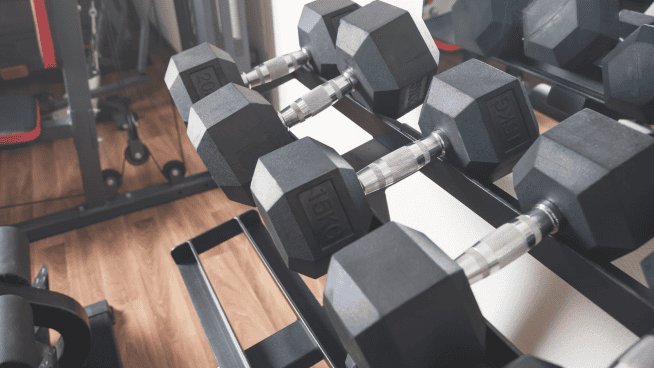Why The ‘Axe’ Bat Is Taking Over Major League Baseball
For over a century, the shape of the baseball bat has remained mostly unchanged.
It’s a symmetrical, cylindrical stick that tapers from the barrel down to a handle that’s capped off with a circular knob. Though the materials and dimensions have changed slightly over time, bat manufacturers have been using the same basic design for most of the last 150 years. However, a new design is making waves throughout the baseball world and even earning some converts at the highest level. Based in part on insights from Ted William’s 1970 book, The Science of Hitting, the new axe-handled bat offers biomechanical advantages over the traditional bat, which can lead to better control, improved bat speed and a reduced risk of injury.
Here’s why the axe-handled bat could become baseball’s next big thing.
Limited By The Lathe
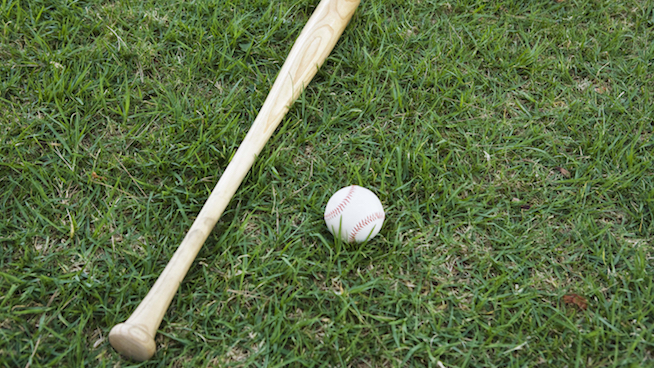
The traditional baseball bat owes its shape to a machine known as a lathe. A lathe is a machine tool that rotates an item on its axis so a worker can perform operations such as sanding or cutting while maintaining symmetry around the axis of rotation. The thickness of the object can be varied in certain spots, but the lathe does not lend itself to making asymmetrical designs. Objects typically produced on a lathe include table legs, candlestick holders, pool cues, gun barrels and baseball bats. Since the lathe was by far the most efficient way to produce baseball bats in the 1800s, the shape became the standard. The design of the traditional baseball bat largely came about because it was easy to produce on a lathe.
Hugh Tompkins, Director of Research and Development at Baden Sports, spoke about this topic to Baseball Prospectus. “A hundred and fifty years ago, the only piece of equipment they had that could mass-produce a bat with a round barrel was a lathe. If you make a round barrel on a lathe, you’ve got to have a round handle. So [the traditional bat design] is really just the limitations of the equipment they had 150 years ago,” Tompkins said.
Baseball has always been an old-school game, but the fact that many players are still swinging bats designed 150 years ago is pretty crazy. Luckily, bat designers no longer have to be limited by the production capabilities of the lathe.
The Advent of The Axe
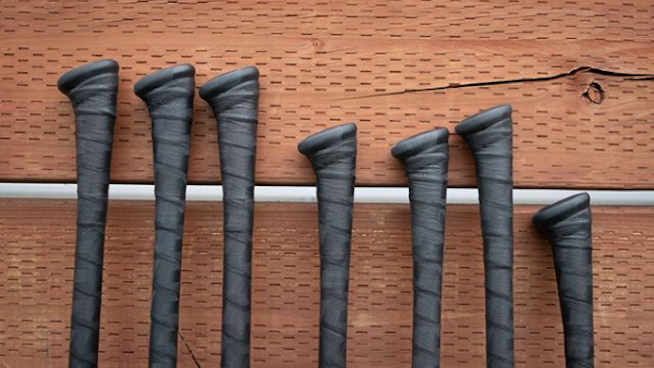
In 2009, a woodworker named Bruce Leinert approached the Washington State-based athletic company Baden Sports with an idea. Leinert spent a lot of time outdoors and, given his profession, he frequently chopped wood. Over time, he noticed how accurately he was able to swing his axe and how comfortable it fit in his hands. Also a baseball fan, Leinert began to percolate the idea that if the handle of an axe fits more comfortably in the human hand and allows for more control than the traditional handle of a baseball bat, why not incorporate that design into a bat? An axe handle is different from a baseball bat handle in that it’s asymmetrical, has a flush backside and does not have a circular “cap” at the bottom.
RELATED: 4 Fundamentals of Hitting a Baseball
Many have compared the perfect baseball swing to the motion of chopping with an axe, the most famous being Ted Williams, who wrote in The Science of Hitting that “[t]he impact of bat on ball is reached not with the wrists rolling, or a ‘wrist’ swing, but with the wrists square and unbroken, as they would be at impact when an ax is swung on a tree.” Leinert patented his design, produced several prototypes of an axe-handled bat, and eventually brought some samples to Baden.
The company was intrigued by the design and decided to partner with Leinert to help bring the product to market. “We tirelessly tested different iterations of handles, working with players at all levels to find the perfect shape,” Baden writes on their website. The result is the Axe bat, the first bat with an asymmetrical handle approved at all levels of baseball and softball.
Advantages of the Axe Bat
So, what advantages does an axe-handled bat hold over the traditional design?
In simple terms, it’s ergonomically designed to be held and swung comfortably. This is not the case with a traditional baseball bat, which has few (if any) elements that make sense from a biomechanics standpoint. The design of the axe-handled bat allows the hands to reach positions that are impossible with a traditional bat, creating a safer, more efficient swing.
A 2014 study funded by Baden sought to compare the biomechanics of the axe-handled bat to those of the standard bat. Led by Dr. Vijay Gupta, Professor of Mechanical and Aerospace Engineering, Professor of Materials Science and Engineering and Professor of Bioengineering at UCLA, the bats were evaluated with respect to “injury potential, comfort, consistency of swing and transfer of power to the ball.” Participants who tested the bats were Division I baseball players. Researchers found the axe-handled design:
- Is more comfortable
- Improves performance based on bat handle kinematics and enhanced grip stability
- Delivers more efficient power from the hands to the bat through reduced tension
- Creates additional bat rotational speed by adding force over a greater swing angle
- Improves bat control and reduce pain
- Reduces hamate bone and ulnar nerve injuries as well as incidents of thrown bats
One major reason for these advantages is that the Axe bat can better act as a natural extension of the hitter’s arms and hands than a traditional bat. Check out this comparative photo, included in the study:
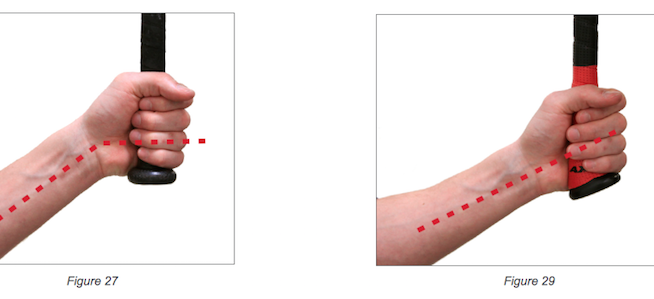
See how the grip, surface area and wrist angle differ? In a game like baseball, where fractions of an inch can be the difference between a home run and a routine fly ball, these factors are important. “The axe handle bat puts the wrist in a more neutral position at the onset of the swing. Also, by eliminating the impingement caused by the back protrusion of the round knob, the same amount of wrist flexion moves the barrel a greater distance. These two factors combine to provide the hitter with 15-20 degrees of additional bat whip and a larger window of opportunity to accelerate the bat. This additional whip can be used to generate greater bat speed at the point of contact with the ball,” the study’s authors write.
The Axe bat also ensures that players make contact with the same side of the barrel on every swing. With a standard bat, every part of the barrel is a potential contact point. But the design of an axe-handled bat forces you to hold it the same way every swing, ensuring only one portion of the barrel will make contact. This “one-sided hitting” allows Baden to give extra attention to the area of the barrel that will make contact, a process you can read more about on their website.
RELATED: Dustin Pedroia’s All-Star Workout
Beyond better performance, there’s reason to believe that Axe bats can reduce frequent injuries that often affect baseball players. The traditional baseball bat’s handle design isn’t just uncomfortable, it can be downright dangerous. It can put an enormous amount of pressure on specific areas of the hand, as seen here:
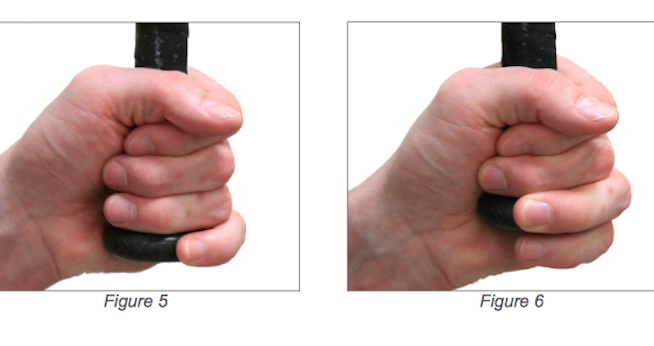
One area in particular that gets frequent abuse is the hamate bone, a small carpal bone located in the lower hand. A huge number of MLB players have suffered hamate fractures at one point in their career, from Ken Griffey Jr. to Giancarlo Stanton . Such an injury often requires surgery and can hamper a player’s performance at the plate for an extended period of time. The Axe bat distributes pressure throughout the hands and fingers, leading to a lower risk of common hitting-related injuries.
An Axe Revolution

Baden currently produces Axe bats for every level of competition, as the bat has been approved in all major, amateur and professional leagues in baseball, fast-pitch softball and slow-pitch softball. In addition to a number of youth and high school teams, several high-profile NCAA teams have become big fans. The University of Washington and University of Memphis baseball teams both make extensive use of Axe bats, as does D-III powerhouse Marietta College.
Axes have also become the go-to bat for several MLB stars. Players who swing an Axe include Mookie Betts, George Springer and Kris Bryant, along with countless others.
“There are things it definitely helps you out with as far as bat speed and control,” Betts, who’s such a big fan of Axe bats that he’s become an official endorser of them, said in a Axe bat video.
As the Axe bat continues to increase its presence in MLB clubhouses, more players will try it. Ramirez recently adopted an Axe Bat while recovering from hamate surgery and smacked two home runs in his first game with it. With several pro players already espousing the benefits of the axe-handle design and a growing amount of research backing their claims, the traditional baseball bat could soon become a relic of the past.
RELATED: These Bat Speed Drills Will Help You Hit Laser Line Drives
Photo Credit: Axe Bat, iStock, Getty Images
RECOMMENDED FOR YOU
MOST POPULAR
Why The ‘Axe’ Bat Is Taking Over Major League Baseball
For over a century, the shape of the baseball bat has remained mostly unchanged.
It’s a symmetrical, cylindrical stick that tapers from the barrel down to a handle that’s capped off with a circular knob. Though the materials and dimensions have changed slightly over time, bat manufacturers have been using the same basic design for most of the last 150 years. However, a new design is making waves throughout the baseball world and even earning some converts at the highest level. Based in part on insights from Ted William’s 1970 book, The Science of Hitting, the new axe-handled bat offers biomechanical advantages over the traditional bat, which can lead to better control, improved bat speed and a reduced risk of injury.
Here’s why the axe-handled bat could become baseball’s next big thing.
Limited By The Lathe

The traditional baseball bat owes its shape to a machine known as a lathe. A lathe is a machine tool that rotates an item on its axis so a worker can perform operations such as sanding or cutting while maintaining symmetry around the axis of rotation. The thickness of the object can be varied in certain spots, but the lathe does not lend itself to making asymmetrical designs. Objects typically produced on a lathe include table legs, candlestick holders, pool cues, gun barrels and baseball bats. Since the lathe was by far the most efficient way to produce baseball bats in the 1800s, the shape became the standard. The design of the traditional baseball bat largely came about because it was easy to produce on a lathe.
Hugh Tompkins, Director of Research and Development at Baden Sports, spoke about this topic to Baseball Prospectus. “A hundred and fifty years ago, the only piece of equipment they had that could mass-produce a bat with a round barrel was a lathe. If you make a round barrel on a lathe, you’ve got to have a round handle. So [the traditional bat design] is really just the limitations of the equipment they had 150 years ago,” Tompkins said.
Baseball has always been an old-school game, but the fact that many players are still swinging bats designed 150 years ago is pretty crazy. Luckily, bat designers no longer have to be limited by the production capabilities of the lathe.
The Advent of The Axe

In 2009, a woodworker named Bruce Leinert approached the Washington State-based athletic company Baden Sports with an idea. Leinert spent a lot of time outdoors and, given his profession, he frequently chopped wood. Over time, he noticed how accurately he was able to swing his axe and how comfortable it fit in his hands. Also a baseball fan, Leinert began to percolate the idea that if the handle of an axe fits more comfortably in the human hand and allows for more control than the traditional handle of a baseball bat, why not incorporate that design into a bat? An axe handle is different from a baseball bat handle in that it’s asymmetrical, has a flush backside and does not have a circular “cap” at the bottom.
RELATED: 4 Fundamentals of Hitting a Baseball
Many have compared the perfect baseball swing to the motion of chopping with an axe, the most famous being Ted Williams, who wrote in The Science of Hitting that “[t]he impact of bat on ball is reached not with the wrists rolling, or a ‘wrist’ swing, but with the wrists square and unbroken, as they would be at impact when an ax is swung on a tree.” Leinert patented his design, produced several prototypes of an axe-handled bat, and eventually brought some samples to Baden.
The company was intrigued by the design and decided to partner with Leinert to help bring the product to market. “We tirelessly tested different iterations of handles, working with players at all levels to find the perfect shape,” Baden writes on their website. The result is the Axe bat, the first bat with an asymmetrical handle approved at all levels of baseball and softball.
Advantages of the Axe Bat
So, what advantages does an axe-handled bat hold over the traditional design?
In simple terms, it’s ergonomically designed to be held and swung comfortably. This is not the case with a traditional baseball bat, which has few (if any) elements that make sense from a biomechanics standpoint. The design of the axe-handled bat allows the hands to reach positions that are impossible with a traditional bat, creating a safer, more efficient swing.
A 2014 study funded by Baden sought to compare the biomechanics of the axe-handled bat to those of the standard bat. Led by Dr. Vijay Gupta, Professor of Mechanical and Aerospace Engineering, Professor of Materials Science and Engineering and Professor of Bioengineering at UCLA, the bats were evaluated with respect to “injury potential, comfort, consistency of swing and transfer of power to the ball.” Participants who tested the bats were Division I baseball players. Researchers found the axe-handled design:
- Is more comfortable
- Improves performance based on bat handle kinematics and enhanced grip stability
- Delivers more efficient power from the hands to the bat through reduced tension
- Creates additional bat rotational speed by adding force over a greater swing angle
- Improves bat control and reduce pain
- Reduces hamate bone and ulnar nerve injuries as well as incidents of thrown bats
One major reason for these advantages is that the Axe bat can better act as a natural extension of the hitter’s arms and hands than a traditional bat. Check out this comparative photo, included in the study:

See how the grip, surface area and wrist angle differ? In a game like baseball, where fractions of an inch can be the difference between a home run and a routine fly ball, these factors are important. “The axe handle bat puts the wrist in a more neutral position at the onset of the swing. Also, by eliminating the impingement caused by the back protrusion of the round knob, the same amount of wrist flexion moves the barrel a greater distance. These two factors combine to provide the hitter with 15-20 degrees of additional bat whip and a larger window of opportunity to accelerate the bat. This additional whip can be used to generate greater bat speed at the point of contact with the ball,” the study’s authors write.
The Axe bat also ensures that players make contact with the same side of the barrel on every swing. With a standard bat, every part of the barrel is a potential contact point. But the design of an axe-handled bat forces you to hold it the same way every swing, ensuring only one portion of the barrel will make contact. This “one-sided hitting” allows Baden to give extra attention to the area of the barrel that will make contact, a process you can read more about on their website.
RELATED: Dustin Pedroia’s All-Star Workout
Beyond better performance, there’s reason to believe that Axe bats can reduce frequent injuries that often affect baseball players. The traditional baseball bat’s handle design isn’t just uncomfortable, it can be downright dangerous. It can put an enormous amount of pressure on specific areas of the hand, as seen here:

One area in particular that gets frequent abuse is the hamate bone, a small carpal bone located in the lower hand. A huge number of MLB players have suffered hamate fractures at one point in their career, from Ken Griffey Jr. to Giancarlo Stanton . Such an injury often requires surgery and can hamper a player’s performance at the plate for an extended period of time. The Axe bat distributes pressure throughout the hands and fingers, leading to a lower risk of common hitting-related injuries.
An Axe Revolution

Baden currently produces Axe bats for every level of competition, as the bat has been approved in all major, amateur and professional leagues in baseball, fast-pitch softball and slow-pitch softball. In addition to a number of youth and high school teams, several high-profile NCAA teams have become big fans. The University of Washington and University of Memphis baseball teams both make extensive use of Axe bats, as does D-III powerhouse Marietta College.
Axes have also become the go-to bat for several MLB stars. Players who swing an Axe include Mookie Betts, George Springer and Kris Bryant, along with countless others.
“There are things it definitely helps you out with as far as bat speed and control,” Betts, who’s such a big fan of Axe bats that he’s become an official endorser of them, said in a Axe bat video.
As the Axe bat continues to increase its presence in MLB clubhouses, more players will try it. Ramirez recently adopted an Axe Bat while recovering from hamate surgery and smacked two home runs in his first game with it. With several pro players already espousing the benefits of the axe-handle design and a growing amount of research backing their claims, the traditional baseball bat could soon become a relic of the past.
RELATED: These Bat Speed Drills Will Help You Hit Laser Line Drives
Photo Credit: Axe Bat, iStock, Getty Images












